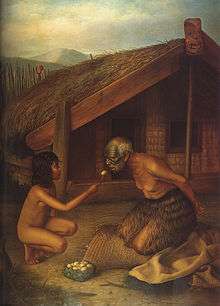Tohunga
In the culture of the Māori of New Zealand, a tohunga (tōhuka in Southern Māori dialect) is an expert practitioner of any skill or art, either religious or otherwise. Tohunga include expert priests, healers, navigators, carvers, builders, teachers and advisors. "A tohunga may have also been the head of a whanau but quite often was also a rangatira and an ariki".[1] The equivalent and cognate in Hawaiian culture is kahuna.
Callings and practices

There are many classes of tohunga (Best 1924:166) including:
- Tohunga ahurewa: highest class of priest
- Tohunga matakite: foretellers of the future
- Tohunga whakairo: expert carvers
- Tohunga tātai arorangi: experts at reading the stars
- Tohunga kōkōrangi: expert in the study of celestial bodies (astronomer)
- Tohunga tārai waka: expert canoe builders
- Tohunga wetereo: expert in the language (linguist)
- Tohunga tā moko: expert in tā moko (tattooist)
- Tohunga mahi toi: expert artist
- Tohunga tikanga tangata: expert in the study of humans (anthropologist)
- Tohunga o Tumatauenga: expert in weapons or war party chaplain
- Tohunga kiato: lowest class of priest
Each tohunga was a gifted spiritual leader and possessed the natural ability of communicating between the spiritual and temporal realms through karakia (prayers), pātere (chants) or performing waiata (songs) that had been passed down to them by tohunga before them. However, their rites were mainly in the specific fields in which they practiced, as outlined above.
Practices and knowledge
Tohunga held knowledge of most spiritual and temporal rites and knowledge in general were passed down through many generations by oral communication at wananga (places of learning/schools). Tools they also used were taonga pūoro for the purpose of calling on divine intervention or assistance from the gods.
Although Māori had high respect for the knowledge and skills of tohunga, there was a darker side too,[2][3] and European settlers often held a very poor opinion of them,[4] something which led to the Tohunga Suppression Act 1907.
Many tohunga declined to pass on their oral traditions after the Act was enforced in New Zealand,[5] leaving Māori people bereft of much of their traditional base, beliefs and practices; at the same time as it hastened assimilation. The Act was repealed in 1962, but by this time, much of the language and traditions had been either corrupted or lost, but a few kaumatua and kuia continued to orally communicate their knowledge through the generations.
One observation to the survival of tohungatanga was the insignificance of the "female tohunga‟ perspective and yet women were the "most powerful tohunga" as they had a direct lineage and link to Te Ira Atua (spiritual realm of the gods) and are a class that have been ignored in any literature until now.
Tohunga under tapu

Tapu was one of the most deeply ingrained beliefs and religious customs of the Māori. The word tapu may be translated as sacred or forbidden, but the Māori tapu has a host of variations. There was a personal tapu and local tapu; tapu of one kind or another faced the Māori everywhere. It often served a purpose similar to some of the Jewish laws of prohibition and quarantine.
Tohunga were imbued with the mysterious essences of the tapu because of their knowledge of ancient and potent karakia, religious ceremonies and their office as mediums of communication with the dread atua. All ariki also had a strong personal tapu which prevented any common person eating out of the same food basket or using anything belonging to the chief.
The remains of the sacred dead and all connected therewith were highly tapu and anyone who had been engaged in handling the dead or bones of the dead would be extremely tapu and would not dare to touch food with the hands. Consequently, such persons had to be fed in the manner shown in the painting here. This was painted from life at an old-time pa (village) in the Wanganui district. The outer palisaded fence of the pa, with its roughly carved posts, usually totara, is shown in the background. The tohunga is kneeling on mats in front of a raupo whare (house) in a remote corner of the settlement.
See also
References
- Mead, S. M. (1997). Landmarks, bridges and visions: Essays. Wellington, New Zealand: Victoria University Press. (p. 197).
- Tregear, Edward (1905). The Maori Race. p. 498.
- Best, Elsdon. "Maori Magic: Notes upon Witchcraft, Magic Rites, and various Superstitions as practised or believed in by the Old-time Maori". National Library of New Zealand. Retrieved 11 April 2017.
- "The Maori superstition in the north" Tuapeka Times, 9 Aug 1893, p. 4.
- "Nga Maumahara: Memory Loss". AUT University. 2011. Retrieved 26 October 2012.
- Best, Elsdon, Māori Religion and Mythology. Dominion Museum, Bull. 10, 1924
- T. R. Hiroa (Sir Peter Buck), The Coming of the Māori. Second Edition. First published 1949. Wellington: Whitcombe and Tombs 1974.